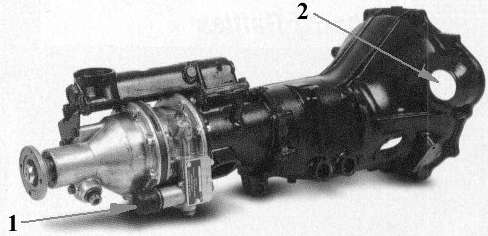Overdrive Transmissions
by Tom Sotomayor
 This article is not intended as a “how to” installation guide, but rather to assist in selecting the correct model overdrive transmission (or OD for short) for any given year MGB. Selecting the proper one from the start will likely be the most cost-effective choice in the long run!
This article is not intended as a “how to” installation guide, but rather to assist in selecting the correct model overdrive transmission (or OD for short) for any given year MGB. Selecting the proper one from the start will likely be the most cost-effective choice in the long run!
An OD gearbox is one of the most endearing and sought after options supplied on our beloved MGBs. It allows the engine to turn fewer revs per mile, meaning less noise, heat, fuel, wear and tear. Most operate on 3rd and 4th gear. Unfortunately, it was not that common an option as installed by the factory. Time has taken its toll on MGBs; the net result is there are a lot of spare, used components available - including OD transmissions.
There exists a fair bit of confusion as to what parts to use. After all, the MGB had an effective life span of 18 years and had numerous design changes during production. What concerns us here, are the basic grouping of the four different transmissions used (two are non-synchro first gear, two are all synchro transmissions). Identification is fairly easy using the information provided. It will be simplest though if we treat the non-synchro first gear transmissions separately from its later cousin, the all synchro unit:
Non-Synchronized 1st Gear Transmission
1962 through 1964 and 1965 through 1967 (chrome bumper)
1. Laycock Type D OD (note external solenoid)
2. A hole in the bell housing where the starter nose pokes through
3. “Shield” shaped access cover
4. 1020 TPM for OD and 1040 TPM for non-OD
5. OD on 3rd and 4th gears

The gearbox input shaft, flywheel and engine backing plate were changed with the advent of the 5 main bearing engine in 1965. Therefore, the transmission for a 3 main bearing engine (1962-1964) will be different than it’s later counterpart. To swap a 3 main bearing car to the later (5 main) 3-synchro transmission or vice versa, requires changing all of the above mentioned parts. The spigot bush in the crankshaft must be changed as well. The 3 main bearing used a .62 inch ID, and the 5 main used a .85 inch ID.
 Fully Synchronized Transmission
1968 through 1974 (chrome bumper)
1. Laycock Type LH OD
2. Rectangular shaped access cover
3. Oval clutch fork boot
4. Dipstick (for checking oil)
5. Black label on the OD solenoid cover
stamped “22/61972”
6. 1280 TPM for OD and non-OD
7. Speedometer drive gear (on the mainshaft)
is blue
8. Speedometer driven gear (on removable
drive housing) is white with 21 teeth
9. OD on 3rd and 4th gears
1974-½ through 1980 (rubber bumper)
1. Laycock Type LH OD
2. Rectangular shaped access cover
3. Square clutch fork boot
4. Side fill plug (NO dipstick)
5. Blue label on the OD solenoid cover stamped “22/62005”
6. 1000 TPM for OD and non-OD
7. Speedometer drive gear (on the mainshaft) is red
8. Speedometer driven gear (on removable drive housing) is red with 20
teeth
9. OD operates in 4th gear only in units made from February 1977 onward
Fully Synchronized Transmission
1968 through 1974 (chrome bumper)
1. Laycock Type LH OD
2. Rectangular shaped access cover
3. Oval clutch fork boot
4. Dipstick (for checking oil)
5. Black label on the OD solenoid cover
stamped “22/61972”
6. 1280 TPM for OD and non-OD
7. Speedometer drive gear (on the mainshaft)
is blue
8. Speedometer driven gear (on removable
drive housing) is white with 21 teeth
9. OD on 3rd and 4th gears
1974-½ through 1980 (rubber bumper)
1. Laycock Type LH OD
2. Rectangular shaped access cover
3. Square clutch fork boot
4. Side fill plug (NO dipstick)
5. Blue label on the OD solenoid cover stamped “22/62005”
6. 1000 TPM for OD and non-OD
7. Speedometer drive gear (on the mainshaft) is red
8. Speedometer driven gear (on removable drive housing) is red with 20
teeth
9. OD operates in 4th gear only in units made from February 1977 onward

Along the way the factory not only changed the transmissions, they also changed the speedometers. Occasionally the change was visually dramatic (changing the gauge face and the size of the case), other times it was simply the calibration - what’s commonly referred to as “TPM” or turns per mile. This refers to the number of times the speedometer cable will turn for every mile traveled.
With the exception of the non-synchro first gear transmissions, there is no functional difference between a speedometer for an OD equipped car and a non-OD one. All USA spec MGB's from 1968 through 1974 used 1280 TPM transmissions and speedometers. From 1974-1/2 through 1980 (all “rubber bumper” cars) it was changed to 1000 TPM. A lot of confusion exists since for the non-synchro first transmissions there is a numerical difference from the OD to non-OD speedometer output. It is 1020 TPM for OD and 1040 TPM for non-OD. Overall, you’re looking at a self induced error of about 2% if you don't swap speedometers. That really wouldn't be too tough to live with.
The serial numbers are different between OD and non-OD speedometers for all synchro cars of any given year, but the TPM remain the same. A non-OD speedometer can be used for an OD application; the end result is the same. The serial number followed by the calibration number can be easily found on the gauge face at roughly the 4:00 position. Also quite a few speedometer 'heads' (where the cable attaches) have the TPM etched into it on the threaded barrel. It's usually fully visible once the works are removed from the case. Fortunately, you don't normally have to get this detailed, or swap speedometers unless you've changed the series of transmission you're using.
Additional items to consider:
1. From 62-67 the OD driveshaft was different from the non-OD driveshaft and
differed depending on the type of axle used. You’ll want to make sure to get
this from whoever is supplying the transmission. The all synchro gearbox used
the same driveshaft regardless if an OD was fitted or not. See chart below
for applications:
Driveshaft Length Std non sync 1st OD non sync 1st Std all sync OD all sync
30 inches banjo axle
31.125 inches tube axle banjo axle tube axle tube axle
32 inches tube axle
2. Overdrive speedometer cables are longer than the standard unit.
3. OD switch
a) 1962-1967 located on the left side of the dash with a chromed bezel
b) 1968-1976 supplied as standard on the wiper stalk
c) 1977-1980 located in the cap of the gearshift knob
Let’s look at some possible “mismatch” scenarios and see what can be done to
fix them:
1. 1967 or earlier MGB with a side fill transmission
The speedometer is calibrated for 1040 TPM and the gearbox has an
output of 1000 TPM. The speedometer will read 4% low. No action
required.
2. 1967 or earlier MGB with a dipstick transmission
The speedometer is calibrated for 1040 TPM and the gearbox has an
output of 1280 TPM. The speedometer will read 23% fast.
a) Get a “converter” box from a speedometer shop
b) Send your speedometer out for recalibration
3. 1968 to 1974 MGB with a side fill gearbox
The speedometer is calibrated for 1280 TPM and the gearbox has an
output of 1000 TPM. The speedometer will read 22% slow.
a) Get a “converter” box from a speedometer shop
b) Send your speedometer out for recalibration
c) Get a used speedometer from a 1975-1976 MGB or Midget (1000 TPM)
4. 1974-½ to 1980 MGB with a dipstick gearbox
The speedometer is calibrated for 1000 TPM and the gearbox has an
output of 1280 TPM. The speedometer will read 28% fast.
a) Get a “converter” box from a speedometer shop
b) Send your speedometer out for recalibration
Mixing early gearboxes with later cars has been intentionally avoided in this analysis for several reasons. They are not as plentiful or robust and they can be quite costly. Best to swap it, or sell it to someone with an early car and get the proper unit for yours.
Hopefully this has answered some of your questions and will enable you to select the proper OD gearbox. Happy motoring!
Next month look for “Driveshafts and U-joints” tech article.





